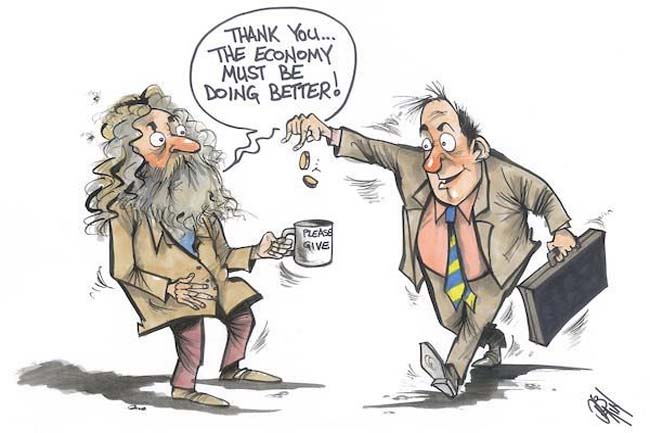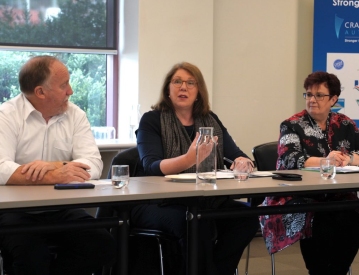The ALP might have had a better chance at the election by offering a sort of Green New Deal inspired by modern monetary theory, writes Dr Steven Hail.
THERE HAS BEEN plenty of bad news recently, but I also have some very good news to offer you. Let’s start with the bad news.
That bad news, if you are a progressive, is that Labor lost an almost unlosable election. There are many reasons to regret this result. You probably know what most of them are and I’m not going to list them here.
Some think Labor was too radical, that they scared the electorate with their Left-wing policies. Some blame Clive Palmer and our Right-wing media. They imagine that Labor has to move to the centre, forget climate change, minimise the distance between itself and the Coalition, become another conservative party and wait for the Liberals to drop the ball.
This is nonsense. It is to criticise the Labor Party for not being the Liberal Party. Labor’s agenda was not radical. Labor had already chosen to minimise the gap between itself and the Government — on refugee policy, on climate change and especially on macroeconomics. Labor had one foot, or at least half a foot, in neoliberalism and a confusing agenda as a result.
Wren's Week: Labor Party down but not outhttps://t.co/DLZOG70NF3
— IndependentAustralia (@independentaus) May 24, 2019
Labor chose not to raise most of the issues (which should have been obvious weapons for a progressive opposition to use to attack the Government) that I mentioned in an article for Independent Australia on 30 April.
There was no discussion of:
- our record household debt;
- nothing about the collapse in household saving;
- little or nothing about the consequences of the property bubble collapsing;
- nothing about the fact that interest rate policy doesn’t work any more as a means to stimulate demand;
- nothing much about underemployment;
- no serious discussion of inequality, poverty and Newstart; and
- not even the beginnings of a rational discussion of the appropriate role for the Government budget to play in achieving and maintaining equitable full employment.
On all these issues, it was pretty much “me too”. When these matters were raised by some of us with the former Assistant Shadow Treasurer, his response was that he was in the sensible centre and to dismiss the need for radical change.
In place of a clear and broad vision for the future, the opposition chose to pick a fight about franking credits. Don’t get me wrong, there is an argument to be made for the proposed changes and a stronger argument for changes to capital gains tax and negative gearing. But given the current economic circumstances in Australia, this was a fight they didn’t need to have.
While I would have loved a Labor Government, this is actually a good time to be in Opposition, because the Tories who said “strong economy” will be eating their words if a recession happens.
— Luca ️ (@keatingism) June 4, 2019
https://t.co/wqZjQvscVE
It missed the point. Labor had the chance to offer the Australian people a positive vision for the future – an Australian Green New Deal, if you like, informed by modern monetary theory – but they ducked the challenge and chose a confusing mix of a small target strategy overall, mixed with an unnecessary fight over small beer tax changes.
Small beer, because the change to franking credits was supposed to “save” $5 billion a year to the budget, in an economy with a budget balance of close to zero at the moment, where the appropriate fiscal balance right now should be a carefully targeted deficit of $50-60 billion. There is so much Labor could have achieved and so many economic opportunities they could have created if they had gone to the election with a coherent vision based on an approach to budgeting consistent with modern monetary theory.
Put briefly, the basics of modern monetary theory are:
- that the only constraint on Government spending in the Australian economy is the productive capacity of our economy (our real resources, including our skills and technology);
- that the Federal Government is a currency issuer, which already creates new dollars every time it spends and which cannot ever run out of its own currency, so that taxes are there to limit total spending and avoid inflation and not to pay for government spending; and
- that the government’s deficit is everybody else’s surplus, so that right now we desperately need the Government to spend significantly more than it withdraws from the economy in taxation.
The economy is weakening. There is talk of the Reserve Bank cutting the cash rate three times, below 1 per cent. The cash rate may eventually be cut to zero. People are talking about the RBA being “out of bullets”. The fact is they never had effective bullets anyway. During the years of the Howard/Costello surpluses, the private sector ran the deficits and household debt skyrocketed. Interest rate cuts won’t help much now. They are a sign of economic weakness. They are a sign that inflation has been below target most of the time for years. They cut the income of savers, even as they reduce the burden on borrowers.
WAS 2019 A GOOD FEDERAL ELECTION FOR LABOR TO LOSE?https://t.co/9HNb0d1s9F https://t.co/9HNb0d1s9F
— Yindi Systems (@yindisystems) June 3, 2019
Australia needs a government which will balance our economy, rather than seeking foolishly to balance its budget. Australia needs a government which rejects the “government as household” metaphor as childish and pernicious. Australia needs a better future to offer people in coal mining areas, a better future for all Australians, a Green New Deal.
This means a positive, coherent agenda. It involves an activist industrial policy and a government taking responsibility for the future economy and society it wishes to create.
The bad news is that this agenda was not on offer in our recent election.
The good news is that it might be on offer in the future. Modern monetary theory is rapidly going mainstream. Critics from the old, failed mainstream, which is so beloved of and so consistent with neoliberalism and all that entails, are becoming more defensive and less self-confident as time goes by. That old mainstream is not going to look any more reliable over the next year or two. A new 600-page textbook on modern monetary theory has sold out very quickly, with a second print run on the way and is continuing to sell like hotcakes.
Investment institutions around the world are waking up to modern monetary theory, learning about it and applying it to guide investment decisions. Modern monetary theory is finding its way into universities, being discussed in small and large groups, among small businesspeople, among trade unionists, among public servants and among politicians.
We are on the brink of a paradigm shift in macroeconomics, even as the old paradigm crumbles and its use as a tool of neoliberalism across the past 40 years becomes increasingly obvious.
Leaders like Bernie Sanders and Alexandria Ocasio-Cortez are relying on modern monetary theorists for macroeconomic advice. In Australia, the demand for a rethink of macroeconomic policy from the grassroots of the ALP and the Australian Greens is getting more and more insistent.
Those issues I mentioned above, which were ignored during our recent election campaign, can be ignored no longer. They offer a path towards a positive, exciting Green New Deal, including a Federal Job Guarantee, which addresses the challenge of building a genuinely sustainable prosperity in Australia’s future. Now, that would be something worth Albo offering to the Australian people in 2022.
But if you want to explain how to make all this happen, Albo, you need to begin now and you need to start by exploding the myth that the Government faces the same financing constraints as a household or a business. You need to explain that Australia, right now, requires private sector surpluses and that this requires a Government deficit. How you spend that deficit – how you create that private surplus – is of crucial importance to the future we want you to fight for.
That is my challenge to Anthony Albanese. Grasp the nettle. Reject neoliberalism. Sense the changes which have begun in so many places around the world as the old mainstream is abandoned. Offer us something much, much better.
You can follow Dr Steven Hail on Twitter @StevenHailAus, as well as on Facebook at Green Modern Monetary Theory and Practice. His new book, 'Economics for Sustainable Prosperity', is due to be released by Palgrave Macmillan in July.Modern monetary theory and the real game ~ Alan Austin https://t.co/7SxpnOtGp8
— IndependentAustralia (@independentaus) March 31, 2019
Ha. They all sound pretty good, esp. the marshmallows and Tim Tams. It's Modern Monetary Theory. Here is an excellent video of Dr Stephanie Kelton when she was recently in Australia:https://t.co/Qt9y4Stw30
— 퐉퐚퐬퐨퐧 퐑퐞퐬퐭퐚퐧퐭퐞 (@Jason_Restante) January 30, 2019
 This work is licensed under a Creative Commons Attribution-NonCommercial-NoDerivs 3.0 Australia License
This work is licensed under a Creative Commons Attribution-NonCommercial-NoDerivs 3.0 Australia License
Support independent journalism Subscribe to IA.












